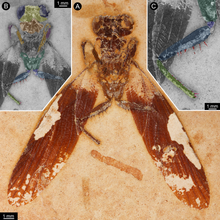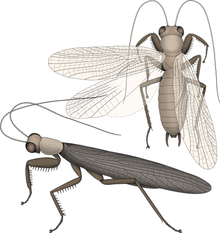Santanmantis
| Santanmantis Temporal range:
| |
|---|---|

| |
| Specimen MB.I.2068 | |

| |
| Life restoration (Note: the spines on the second set of legs have been considered questionable by other authors) | |
| Scientific classification | |
| Domain: | Eukaryota |
| Kingdom: | Animalia |
| Phylum: | Arthropoda |
| Class: | Insecta |
| Order: | Mantodea |
| Family: | †Santanmantidae Grimaldi 2003 |
| Genus: | †Santanmantis Grimaldi, 2003 |
| Species: | †S. axelrodi
|
| Binomial name | |
| †Santanmantis axelrodi Grimaldi, 2003
| |
Santanmantis is an extinct genus of mantises, the sole genus in the family Santanmantidae. The only species, Santanmantis axelrodi , is known from the Crato Formation of Brazil, dating to the late Aptian stage of the Early Cretaceous.[1][2][3] It is amongst the most primitive known lineages of mantis.[4] Like other mantises, the forelegs are modified into spined raptorial appendages. When describing a new specimen in 2017, Hörnig, Haug and Haug proposed that the second set of legs also had spines similar to the forelegs, and also served a raptorial function, but that they were not visible in the fossil due to being broken off.[5] However a response to this paper criticised this assumption, finding that it had little evidence from the fossil itself or from living mantises.[6]
References[edit]
- ^ "Santanmantis". GBIF. Retrieved 2019-05-11.
- ^ "The Paleobiology Database, genus Santanmantis". Retrieved 2019-05-11.
- ^ Otte, Daniel; Spearman, Lauren; Stiewe, Martin B. D. (2019). "genus Santanmantis Grimaldi, 2003". Mantodea species file online, Version 5.0. Retrieved 2019-05-11.
- ^ Demers‐Potvin, Alexandre V.; Larsson, Hans C.E.; Cournoyer, Mario; Béthoux, Olivier (January 2021). "Wing morphology of a new Cretaceous prayin g mantis solves the phylogenetic jigsaw of early‐diverging extant lineages". Systematic Entomology. 46 (1): 205–223. doi:10.1111/syen.12457. ISSN 0307-6970. S2CID 231391397.
- ^ Hörnig, Marie K.; Haug, Joachim T.; Haug, Carolin (2017-07-24). "An exceptionally preserved 110 million years old praying mantis provides new insights into the predatory behaviour of early mantodeans". PeerJ. 5: e3605. doi:10.7717/peerj.3605. ISSN 2167-8359. PMC 5527957. PMID 28761789.
- ^ Brannoch, Sydney K.; Svenson, Gavin J. (2017-11-16). "Response to "An exceptionally preserved 110 million years old praying mantis provides new insights into the predatory behaviour of early mantodeans"". PeerJ. 5: e4046. doi:10.7717/peerj.4046. ISSN 2167-8359. PMC 5694651. PMID 29158979.
